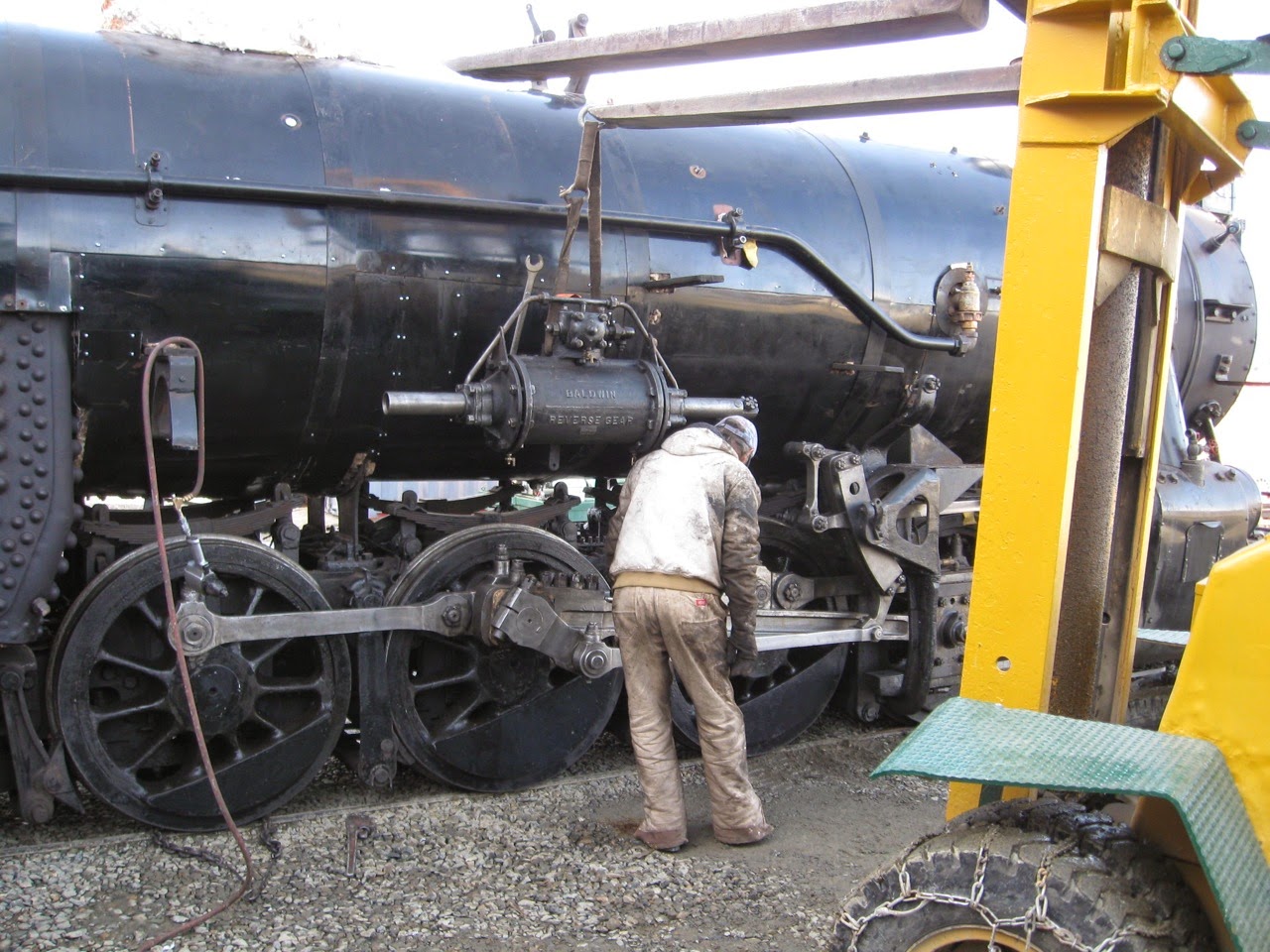Slowly but surely the overhaul of number 19 progressed through the summer of 2013, with the goal being that number 19 would return to service before the year was out. Ideally, it was hoped it would be available for the Photographer's Weekend in October, but the December Christmas Trains were more likely.
The new rear section of the door sheet is being drilled for staybolts and rivets.
The old rear door sheet on number 19. Note where the old rivets and stays have been removed in preparation for fitting the new sheet.
The new fireman's side check valve reinforceing plate is finished and the new studs have been installed.
Looking in through the top of the steam dome on number 19. You can see that the new tubes have all been installed, and are nice and shiny black. The open pipe in the bottom center is the dry pipe that leads to the cylinders. The surface has been lapped in preparation for the instillation of the throttle .
On the steam dome are the original markings from 1920. ALCO is the American Locomotive Company of Schenectady, New York, and 61981 is the construction number for number 19.
An overall view of the steam dome just before the throttle is installed.
Lowering the throttle body into the dome. The large "U" bolt holds the throttle body onto the dry pipe, though getting everything to fit correctly makes for a challenging instillation.
A short while later, and after a large amount of swearing and bruised knuckles, the throttle is back in place. Next on the reassembly is the steam dome lid gasket and the lid itself.
Number 19 basks in the sunshine for the first time in over a year as she is readied for her initial hydro test.
No major leaks or problems were found during the hydro test. The FRA has given us the go ahead to reassemble in preparation for a steam test.
With the hydro test successfully behind us, volunteers began the task of reassembling number 19 in preparation for the steam test. Most parts came directly out of storage and were able to be bolted right back in place. There were a few pieces that needed some attention though. Eric Wunz is pictured touching up a thin spot on the smokebox door.
The cab floor which had been removed for the firebox repairs has been reassembled and installed.
Eric Wunz, Taylor Rush, and Jim Grigsby installed the new firebrick in the firebox. it was a definite learning experience as the pattern had to be modified to accommodate some modifications that had been made to the fire pan.
Hooking up air lines and hoses beneath the cab.
The firing stand has been reinstalled in preparation for the first steam test.
Hooking up the tenders hoses and inspecting the drawbar and buffer plates between the locomotive and tender.
The last of the firebrick is in place and is being allowed to set for a week before the locomotive is fired up.
Bret Bane has overhauled the dynamo for number 19, and Heisler number 3 is providing the steam to test and adjust it.
After a bit of adjustment the dynamo is performing just like it should.
Most of the back head has been reassembled for the first steam up. During the test the major appliances on the locomotive will also be checked to assure that they function correctly.
The first fire in her since 2010.
The air compressor worked like a champ, needing only a light cleaning and a regular servicing.
Number 19 lets the valley know that she is back in business. The steam test was a success and the FRA approved the number 19 for a full return to service.
Despite a large amount of effort, number 19 wasn't ready for the October Photographer's Weekend, though December was believed to be an achievable goal. The reassembly team was going for broke, and in this picture you can see that most of the boiler lagging and jacketing has been reinstalled, as well as most of the piping and lubricator lines.
The air-operated power reverse is being reinstalled on the engineer's side. This appliance was added on the White Pass & Yukon and was actually supplied by the Baldwin Locomotive Works. As built, number 19 had a manual Johnson Bar, similar to what Heisler number 3 is still equipped with.
As the sun sets number 19 is almost fully reassembled and ready for service.
Number 19 is back in business and ready for Christmas!























































